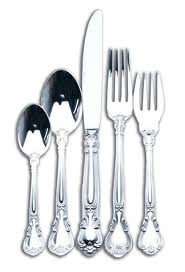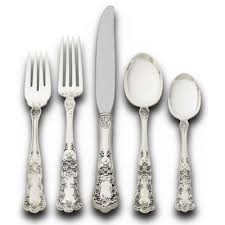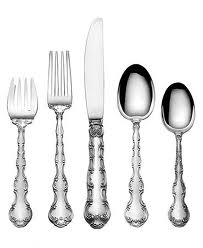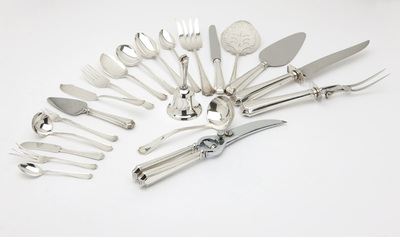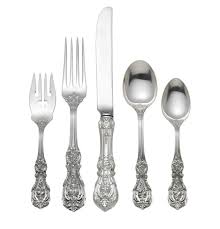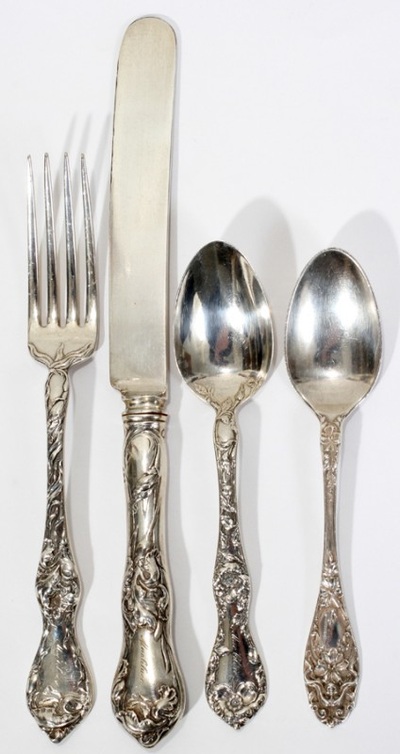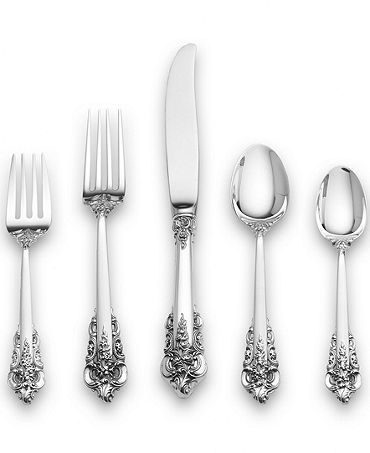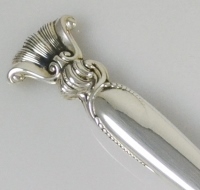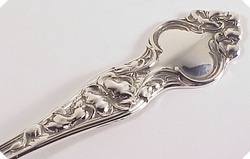Sterling Silver Patterns -- Partial List
We carry a wide selection of Sterling and Plate. Here are only a few!18th Century
Acorn-Georg Jensen American Classic American Victorian Angelique Audubon Bridal Rose Burgundy Buttercup Cactus-Georg Jensen Cambridge-Gorham Candlelight Canterbury Carmel Carthage Castle Rose Chantilly Chateau Rose Classic Rose Damask Rose Debussy Douvaine Du Barry-Intl. El Grandee Eloquence Enchanting Orchid English Gadroon Etruscan |
|
Silver Plated Patterns -- Partial List
|
Adam
Adoration Affection Aldine Alhambra Ambassador American Beauty Rose 1904 American Beauty Rose 1909 Ancestral Anniversary Antique Egyptian April Arbutus Arcadian Assyrian Head Avon - 1847 Rogers Bros. Baroque-Wallace Berkshire - 1847 Rogers Bros. Berwick/Diana Bird of Paradise Blossom Bordeaux Brides Bouquet Burgundy/Champaigne Caprice Cardinal-Wallace Carlton-1881 Rogers Carnation-W.R. Keystone Noblesse - Community
Oak/Royal Oak Old Colony Orange Blossom Orient/Venice Oxford 1901 Patrician 1914 Paul Revere Queen Bess-1946 Remembrance - 1847 Rogers Bros. Roman Medallion Romance 1952 Romanesque Rose 1903 Rose 1909 |
Sharon - 1847 Rogers Bros.
Sheraton Siren South Seas Spring Garden Sunkist Thistle 1906 Thistle 1911 Tiger Lily/Festivity Troy Vintage White Orchid Yale 1894 Youth |
Silver Pattern FAQs
Q. How does one tell real silver (sterling) from silver plate?
A. It is not as easy as one would think, due to some makers and retailers trying to mislead one into thinking silver plate is real silver. Also, the absence of marks on silver plate adds to the confusion.
Let's deal with American silver only, as this encompasses most of what we see in this country.
(For the record, every country possesses different marks, quality of silver, regulations and so on. Canadian and Mexican marks are quite similar to American ones, while the United Kingdom, Scandinavia, Germany, the Netherlands, France, Russia and etc., are quite different).
The most common misconception I encounter is "It must be real silver because it tarnishes." Often I hear the exact reverse of this.
Not true. Both sterling and silver plate tarnish.
“Sterling” means 92.5% pure silver mixed with 7.5% alloy, usually copper. Pure silver is too soft for eating utensils and would also wear out in a matter of years if subjected to constant use. Just as pure gold is too soft for rings, pure silver is too soft for flatware. The term "sterling" goes back hundreds of years to England and Germany.
On occasion, makers may use 95.0% silver when they are doing hand engraving on fine pieces of holloware and would rather give away some silver to reduce the amount of time needed to do the hand engraving.
Real silver is usually marked:
- Sterling
- Sterling Silver
- .925
- .925/1000
Pieces marked as the following are not real silver and usually contain no silver:
- Silver
- Alpaca
- Alpaca Silver
- Peru Silver
- Brazil Silver
- German Silver
(The usual composition is 3 parts copper, 1 part zinc, one part nickel.)
Silly as it seems, if it says “silver” and not “sterling silver,” it means it’s not actually silver!
Silver plating was first invented in 1841 by Elkington Co. in England. In America, The Roger Brothers started producing large quantities of silver plate in 1847.
There are around 1,200 American silver plate patterns, of which about 165 are popular and considered collectible. Two of these – "Holly" and "Moselle" – tend to be more expensive than almost any sterling patterns. The elaborate die-work that went into creating the patterns, the exquisite details and beauty and rarity make them very desirable and collectible.
One maker's name in particular might confuse the public: Sterling Silver Mfg. Co. produced flatware back-stamped with their name and – in most cases – the pieces are not sterling but silver plate.
Silver plate is a base metal, usually copper, that is electroplated with pure .999 silver. On occasion I have seen it plated with .925 sterling silver.
Sometimes a piece says "silver plate" but more often it does not. It is more the absence of real silver designations that indicate silver plate.
- “EPC” on a piece means electro plated copper.
- “EPNS” means electro plated nickel silver.
- “EPBM” means electro plate base metal.
- “EP” means electro plate, as well as A1, X, XX, XX, XXX.
- “Silver soldered” means electro plate.
"Coin" silver is 90% pure silver and prior to 1837 89.2% pure. After the American Civil War most American companies switched from coin to sterling as their standard. Some of the Baltimore companies used sterling as their standard starting in the early 1800's.
Some coin pieces are marked "coin" but most are not. Quite often it is only back stamped with the name of the maker.
It would be best to read about "coin" or attend antique shows and have a knowledgeable dealer show you examples of coin silver pieces and point out the various marks.
Here are some examples of sterling patterns that are extremely popular today (Below, left to right. Click each picture to enlarge):
- Gorham "Chantilly" (1895)
- Gorham "Buttercup" (1900)
- Gorham "Strasbourg" (1897)
- Gorham/Durgin "Fairfax" (1910)
- Reed & Barton "Francis I" (1907)
- Reed & Barton "Love Disarmed" (1899)
- Reed & Barton "Les Cinq Fleurs" (1901)
- Wallace "Grande Baroque" (1941)
The list could go on for pages but you get the idea; what was popular years ago is primarily what is still popular now with collectors and users of silver. The same is true of silver plate.
The highly popular, beautiful, and expensive pieces were introduced from about 1900-1918, and again from the late 1930's to about 1950. There is a huge interest today in the Aesthetic patterns of the late 1870's until about the mid 1890's.
Always collect what you like, but best practice is collecting numerous pieces and patterns, and not only one pattern.
The highly popular, beautiful, and expensive pieces were introduced from about 1900-1918, and again from the late 1930's to about 1950. There is a huge interest today in the Aesthetic patterns of the late 1870's until about the mid 1890's.
- 1847 Rogers Bros. "Vintage" (1904)
- ASC "Moselle" (1906)
- E.H.H. Smith "Holly" (1904)
- 1847 Rogers Bros. "Charter Oak" (1906)
- 1847 Rogers Bros. "First Love" (1937)
- 1847 Rogers Bros. "Daffodil" (1950)
Always collect what you like, but best practice is collecting numerous pieces and patterns, and not only one pattern.
Q. Do you have a favorite pattern regarding Sterling Silver? If so, what?
At antique shows I am frequently asked this question, especially by people looking to start a pattern or add other patterns to their collecting.
I have four:
At antique shows I am frequently asked this question, especially by people looking to start a pattern or add other patterns to their collecting.
I have four:

“Waltz of Spring” (Sterling) introduced by Wallace in 1952 and designed by William S. Warren, one of my favorite designers.
Warren described the pattern as his interpretation of a dancer spinning around. I love the clean design and the curvatures on all pieces fit your hands. It is the most practical and comfortable pattern I have ever used; it is not too fancy and it is not too plain.
My favorite piece of Rose Point hollowware is the mayo bowl with attached under tray. The pierced pattern reflects from the round base onto the totally plain bowl. Stunning! It is well designed and thought out. His hollowware in "Grande Baroque" and "Rose Point" commands high prices because of the beauty, function and design.
Many of the Gorham patterns from about 1894 to 1914 designed by William Christmas Codman are superb. Examples are "Chantilly," "Buttercup," "Lancaster," "Strasbourg," "Cambridge" and dozens more. Good designers could create superb fancy AND simple patters as well as middle of the road ones. They created large numbers of excellent patterns.
Most of the dozens of today's very popular patterns were designed by just a handful of men. Yes, there were women designers also. Mary Parker Fleming teamed with Grosvenor N. Allen to create Oneida's most popular sterling pattern "Damask Rose" which was first introduced in 1946.
One interesting thing I have noticed over the years is that almost without exception, if one likes “Waltz of Spring” they often also like Wallace's “Romance of the Sea,” (Sterling) introduced in 1950. William S. Warren created dozens of spectacular patterns from the early 1930's until the 1960's. Some of his well-known and popular sterling patterns are "Grande Baroque," "Rose Point," "Stradivari," "Grand Colonial," "Romance of the Sea," "Waltz of Spring," "Sir Christopher" and on and on. They are well designed front, back and side and well balanced. They feel heavy in the hand, and the way the light hits the ridge on the handle of "Grand Colonial" flatware is striking.
And speaking of…
Warren described the pattern as his interpretation of a dancer spinning around. I love the clean design and the curvatures on all pieces fit your hands. It is the most practical and comfortable pattern I have ever used; it is not too fancy and it is not too plain.
My favorite piece of Rose Point hollowware is the mayo bowl with attached under tray. The pierced pattern reflects from the round base onto the totally plain bowl. Stunning! It is well designed and thought out. His hollowware in "Grande Baroque" and "Rose Point" commands high prices because of the beauty, function and design.
Many of the Gorham patterns from about 1894 to 1914 designed by William Christmas Codman are superb. Examples are "Chantilly," "Buttercup," "Lancaster," "Strasbourg," "Cambridge" and dozens more. Good designers could create superb fancy AND simple patters as well as middle of the road ones. They created large numbers of excellent patterns.
Most of the dozens of today's very popular patterns were designed by just a handful of men. Yes, there were women designers also. Mary Parker Fleming teamed with Grosvenor N. Allen to create Oneida's most popular sterling pattern "Damask Rose" which was first introduced in 1946.
One interesting thing I have noticed over the years is that almost without exception, if one likes “Waltz of Spring” they often also like Wallace's “Romance of the Sea,” (Sterling) introduced in 1950. William S. Warren created dozens of spectacular patterns from the early 1930's until the 1960's. Some of his well-known and popular sterling patterns are "Grande Baroque," "Rose Point," "Stradivari," "Grand Colonial," "Romance of the Sea," "Waltz of Spring," "Sir Christopher" and on and on. They are well designed front, back and side and well balanced. They feel heavy in the hand, and the way the light hits the ridge on the handle of "Grand Colonial" flatware is striking.
And speaking of…
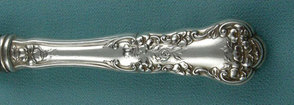
“Pansy” (Sterling) was introduced in 1909 by International Silver Co. It was designed by Samuel Stohr who also created the fabulous silver plate pattern, Vintage, in 1904.
I like almost all of Stohr's designs. The pansies are stunning and are especially beautiful on the salad forks towards the times and the bowls and ends of berry spoons, cold meat forks, gravy ladles and so on. The pattern reminds one of Gorham's “Buttercup” but, in my opinion, “Pansy” is much more beautiful.
I like almost all of Stohr's designs. The pansies are stunning and are especially beautiful on the salad forks towards the times and the bowls and ends of berry spoons, cold meat forks, gravy ladles and so on. The pattern reminds one of Gorham's “Buttercup” but, in my opinion, “Pansy” is much more beautiful.
The end of serving pieces and the bowls are GORGEOUS with the violets in the berry spoon bowls. I adore the violets in the bowls of the ice tea spoons and grapefruit spoons. Most designers do these place pieces with unadorned or simple bowls.
Q. Do you have a favorite silver plate pattern? If so, what?
I like the faceting towards the tines of the salad forks, as well as inside the bowls of the sugar spoon, gravy ladle, and large berry spoon. The pierced dessert server, pierced tomato server, and pierced bon bon/nut spoon are gorgeous.
It was so popular that a large assortment of holloware pieces was made. Some of my favorites are the water pitcher and the demitasse set consisting of creamer and sugar. The demi pieces are fluted or sectioned.
It was so popular that a large assortment of holloware pieces was made. Some of my favorites are the water pitcher and the demitasse set consisting of creamer and sugar. The demi pieces are fluted or sectioned.
Q. So, who’s the best maker of silver and why is one maker worth more than another? What makes a “good” piece of silver?
A. While there is no such thing as the "best" maker, certain makers are certainly known for their quality and the cost of their products reflect this. Quality consists of good weight, design, balance, oxidation/patina, finish. Generally, the more intricate the pattern, the more craftsmanship was required, hence the higher price. And, of course, the more intricate the pattern, the heavier the piece.
One bought individual pieces called "dozens" by weight in the late 1800's until about 1918. Gorham offered five weights. From lightest to heaviest they are Trade, Extra, Regular, Heavy and Massive. One paid according to the weight. A dozen teaspoons in Chantilly weighed 12 ounces troy in Regular weight.
(I often have requests from people who want the “good, old, heavy silver.” In reality, good old “Trade” and “Extra” weights are lighter than current production, and regular weight is about the same as current production. “Massive” is extremely rare as people did not feel the extra money for a little more weight than “Heavy” was worth it.)
Wallace, Reed & Barton, and others worked primarily in Regular and Heavy weights and one paid accordingly.
Makers offered multiple weights only in functional pieces with heavy usage such as luncheon forks, dinner forks, teaspoons, 5 o'clock teaspoons, serving spoons, oval soup spoons, gumbo soup spoons.
Multiple weights were NOT offered in knives, salad forks, ice cream spoons and forks, flat individual butter spreaders, ice tea spoons, demitasse spoons, cocktail forks, flat master butter knives, gravy ladles, berry spoons, cold meat forks, jelly servers, sugar shells, etc.
The weight of a pattern is primarily a function of what it takes in thickness of silver to create the desired design. For example, the "Love Disarmed" pattern by Reed & Barton with a maiden in a filmy, flowing gown clutching a cherub is astounding for its beauty and weight. The reverse of the handle is beautiful with three dimensional floral design. To achieve the pattern Reed & Barton made "Love Disarmed" twice as heavy as Francis I, and it is much heavier than Wallace's "Grande Baroque."
On a more personal note, I feel that -- to a large extent -- the more things change the more they stay the same. This is certainly true of sterling and silver plate patterns. Beauty seems timeless, and the spiritual appeal of a gorgeous pattern does not know time limits. Artistry in silver that is stunning in 1890 remains so in 2014. It is a certain something that seems to appeal to the soul. We like things that flow (art nouveau) and things that are linear and broken and streamlined (art deco).
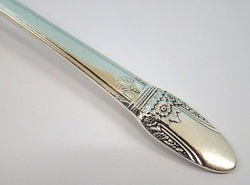
Why does "First Love by Intl. 1847 Rogers Brothers in silver plate appeal to generation after generation?
It is hard to put your finger on it but it appeals to our spiritual side of beauty and it is just the right blend of floral, art deco and perhaps art nouveau. Bottom line is millions of us love it because it is what it is. We cannot define it, yet we simply know it. Gorham's sterling pattern "Chantilly (1895) is the most popular pattern ever created in silver.
Why? I feel it is because in our deepest interiors we feel the beauty. No one has to tell us. We know it. It flows, it is simple yet it is complex. It is the perfect blend that matches what the human soul perceives itself to be, and thus, we love it because it is us.
It is hard to put your finger on it but it appeals to our spiritual side of beauty and it is just the right blend of floral, art deco and perhaps art nouveau. Bottom line is millions of us love it because it is what it is. We cannot define it, yet we simply know it. Gorham's sterling pattern "Chantilly (1895) is the most popular pattern ever created in silver.
Why? I feel it is because in our deepest interiors we feel the beauty. No one has to tell us. We know it. It flows, it is simple yet it is complex. It is the perfect blend that matches what the human soul perceives itself to be, and thus, we love it because it is us.

